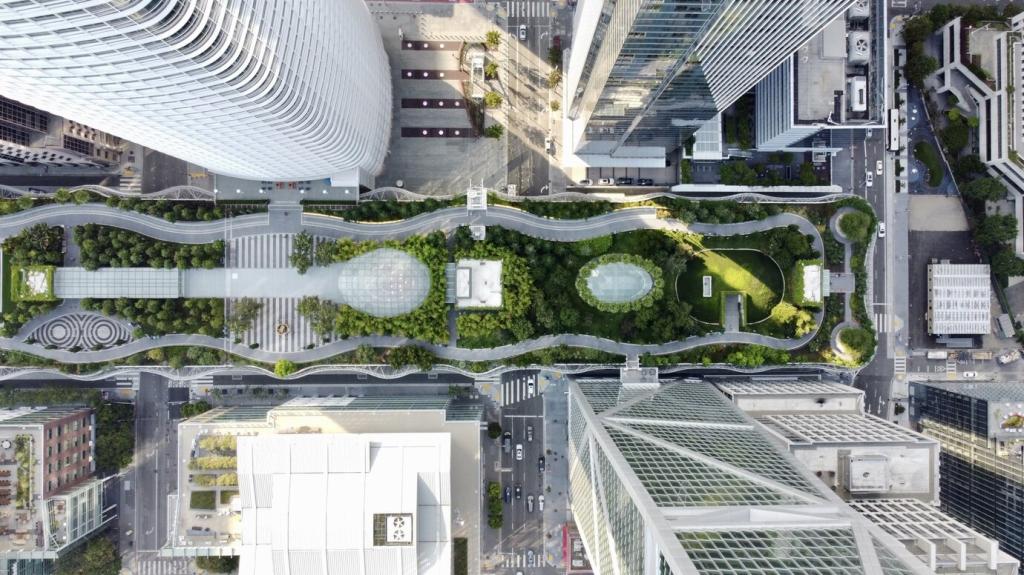Green infrastructure is redefining how cities interact with their environments by integrating natural systems and sustainable techniques into urban planning. Urban resilience, meanwhile, refers to a city’s ability to adapt, survive, and thrive amidst various challenges—be they environmental, social, or economic. By weaving green infrastructure into the urban fabric, cities become healthier, more sustainable, and better equipped to withstand pressures such as climate change, population growth, and natural disasters. Addressing both present needs and future risks, the synergistic relationship between green infrastructure and urban resilience is key to creating vibrant, livable communities for generations to come.
Foundations of Green Infrastructure
01
Green infrastructure consists of strategically planned networks of natural and semi-natural features within urban environments, ranging from tree-lined streets and community gardens to expansive greenways and wetland buffers. Unlike conventional gray infrastructure, which relies on impermeable surfaces and engineered solutions, green infrastructure harnesses ecological functions to provide numerous benefits. It is designed not just to beautify cities, but to actively contribute to improved water quality, air purification, and overall urban health. By prioritizing green approaches at every scale, from neighborhood parks to city-wide networks, municipalities can foster more resilient and adaptive urban systems.
02
Urban resilience describes a city’s capacity to withstand and quickly recover from adverse situations, including climate-related events, economic shifts, and societal disruptions. Integrating green infrastructure strengthens this resilience by enhancing the natural defenses of urban environments. By reducing flood risks, moderating temperatures, and supporting biodiversity, nature-based solutions form the backbone of adaptive urban planning. Cities that proactively invest in green infrastructure are not only better prepared for emergencies but are also able to maintain essential services and quality of life under a range of future scenarios.
03
Ecosystem services are the multitude of benefits that natural systems provide to urban residents, such as clean air, fresh water, temperature regulation, and recreational opportunities. Green infrastructure enhances these services by creating habitats for wildlife, filtering pollutants, and absorbing excess rainwater. By recognizing and valuing these ecosystem contributions, city planners and policymakers can make informed decisions that prioritize both human well-being and ecological vitality. In doing so, urban areas become healthier, more attractive, and more equipped to cope with environmental stresses.
Benefits of Urban Green Infrastructure
Integrating green infrastructure brings tangible environmental improvements to urban spaces. Not only does it aid in mitigating the impacts of air pollution, it also enhances local biodiversity by providing habitats and corridors for native species. Trees, wetlands, and vegetated surfaces help sequester carbon, reduce the urban heat island effect, and filter out harmful contaminants from both air and water. These ecological enhancements support cleaner and healthier urban living, while also contributing to the broader fight against climate change. The cumulative effect leads to more robust and resilient urban ecosystems.

Climate Change Mitigation and Adaptation
As cities grow, impervious surfaces like roads and rooftops prevent the natural absorption of rainwater, leading to increased flooding and water pollution. Green infrastructure addresses this through features such as bioswales, permeable pavements, and rain gardens, which allow stormwater to infiltrate and be filtered by soil and vegetation. These solutions not only manage runoff more effectively but also recharge groundwater and support urban biodiversity. By mimicking natural hydrological processes, cities can minimize flood risks, reduce sewer overflows, and protect water resources, safeguarding urban communities from climate-induced emergencies.
Community Engagement and Participation

Community engagement begins with inclusive and transparent planning processes. By actively involving citizens in the design and implementation of green infrastructure, cities can create solutions that reflect local priorities and cultural values. Workshops, public forums, and partnerships with neighborhood organizations allow residents to voice their preferences, raise concerns, and contribute creative ideas. Through these participatory forums, green infrastructure projects achieve broader support and are more likely to meet community needs, resulting in spaces that are well-used, well-loved, and well-maintained over time.
Urban Planning and Policy Integration
Regulatory Frameworks and Incentives
Effective policies form the backbone of green infrastructure expansion. Municipal governments can enact zoning ordinances, stormwater regulations, and development guidelines that require or incentivize the inclusion of green features in new projects. Tax credits, grants, or density bonuses can motivate private developers and landowners to embrace nature-based solutions. By aligning regulatory incentives with environmental objectives, cities create favorable conditions for widespread adoption of green infrastructure, ensuring that both public and private efforts contribute to resilient urban systems.


Previous slide
Next slide
Financial and Economic Constraints
Securing the necessary funding for green infrastructure projects remains a major obstacle for many municipalities. Initial capital outlays may appear high compared to conventional infrastructure, even though long-term savings and co-benefits often outweigh these upfront costs. Limited public budgets, uncertainties about cost-effectiveness, and a preference for immediate returns can impede investment decisions. Overcoming financial barriers demands creative funding mechanisms, such as leveraging public-private partnerships, green bonds, or ecosystem service payments, to ensure that long-term gains are recognized and prioritized in budgeting processes.
Institutional Inertia and Capacity
Organizational inertia and a lack of capacity can significantly slow the shift toward green infrastructure. Many city departments remain accustomed to traditional approaches and may lack the expertise needed to design, implement, or maintain nature-based solutions. Policy silos and fragmented responsibilities can create confusion and duplication of effort. Addressing these challenges requires ongoing training, leadership buy-in, and the establishment of clear institutional frameworks. Building multidisciplinary teams and fostering a culture of experimentation and learning are essential for overcoming resistance and equipping agencies for the new era of urban resilience.
Competing Land Use Demands
Urban land is a precious commodity, with intense competition between housing, commercial uses, transportation corridors, and green space. The pressure to maximize developable land can push green infrastructure down the priority list. To counter this, cities must adopt land use policies that recognize the multifunctional value of green spaces and embed ecological thinking into redevelopment projects. Creative solutions, like combining infrastructure upgrades with greening initiatives or integrating vegetation into vertical surfaces, make it possible to balance competing demands and ensure that green infrastructure maintains a central place in the urban landscape.
